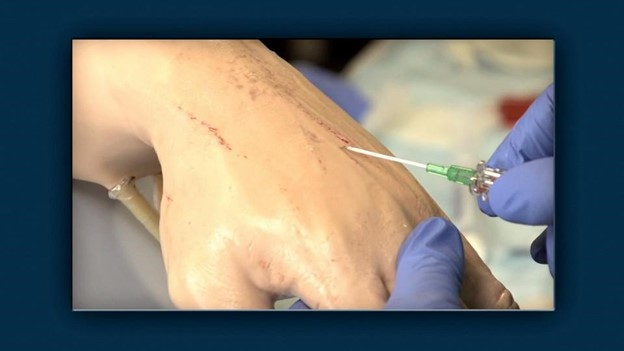A nurse is caring for a client who has a prescription for a peripheral IV catheter.
After puncturing the skin with the vascular access device and noting a blood return in the flashback chamber, which of the following actions should the nurse perform next?
Flush the catheter with saline
Retract the stylet
Release the tourniquet
Advance the catheter into the vein
The Correct Answer is D

This is because after puncturing the skin and the vein, the nurse needs to advance the catheter into the vein with the finger hub to ensure proper placement and prevent complications such as infiltration or phlebitis.
Choice A is wrong because flushing the catheter with saline should be done after securing the catheter to the skin with a transparent dressing and attaching a primed piece of extension tubing to the catheter.
Choice B is wrong because retracting the stylet should be done after advancing the catheter into the vein and releasing the tourniquet from the client’s arm.
Choice C is wrong because releasing the tourniquet should be done after advancing the catheter into the vein and before retracting the stylet.
Nursing Test Bank
Naxlex Comprehensive Predictor Exams
Related Questions
Correct Answer is B
Explanation
Choice A Reason:
Urine specific gravity: The specific gravity of 1.035 indicates concentrated urine and might be indicative of dehydration. However, the nurse should address this finding by encouraging increased fluid intake before reporting it to the provider.
Choice B Reason:
Prealbumin: The prealbumin level is 25 mg/dL. Prealbumin is a marker of nutritional status and can indicate the adequacy of protein intake and overall nutritional status. A level of 25 mg/dL is relatively low, which may suggest malnutrition or insufficient protein intake. This finding should be reported to the provider so that appropriate interventions can be initiated to address the client's nutritional needs.
Choice C Reason:
Temperature: The temperature is not mentioned in the provided information. If the temperature is within the normal range, there is no need to report it to the provider.
Choice D Reason:
Blood pressure: The blood pressure is not mentioned in the provided information. If the blood pressure is within the normal range, there is no need to report it to the provider.
It's important for the nurse to critically assess the client's medical record and prioritize the findings that require immediate attention or intervention. In this case, the low prealbumin level indicates a potential nutritional issue that needs to be addressed promptly. The nurse should communicate this finding to the healthcare provider to ensure appropriate management and care for the client.
Correct Answer is A
Explanation
The correct answer is A. Beneficence. Beneficence is the ethical principle of doing good for the patient and promoting their well-being.
The nurse is demonstrating beneficence by sitting with the client to provide comfort and support during a difficult time.
Choice B is wrong because fidelity is the ethical principle of keeping promises to the patient and being loyal and faithful.
The nurse is not making or keeping any promises to the client in this scenario.
Choice C is wrong because autonomy is the ethical principle of respecting the patient’s right to make their own decisions and choices.
The nurse is not interfering with the client’s autonomy in this scenario.
Choice D is wrong because veracity is the ethical principle of telling the truth to the patient and being honest and trustworthy.
The nurse is not lying or withholding information from the client in this scenario.
Whether you are a student looking to ace your exams or a practicing nurse seeking to enhance your expertise , our nursing education contents will empower you with the confidence and competence to make a difference in the lives of patients and become a respected leader in the healthcare field.
Visit Naxlex, invest in your future and unlock endless possibilities with our unparalleled nursing education contents today
Report Wrong Answer on the Current Question
Do you disagree with the answer? If yes, what is your expected answer? Explain.
Kindly be descriptive with the issue you are facing.
